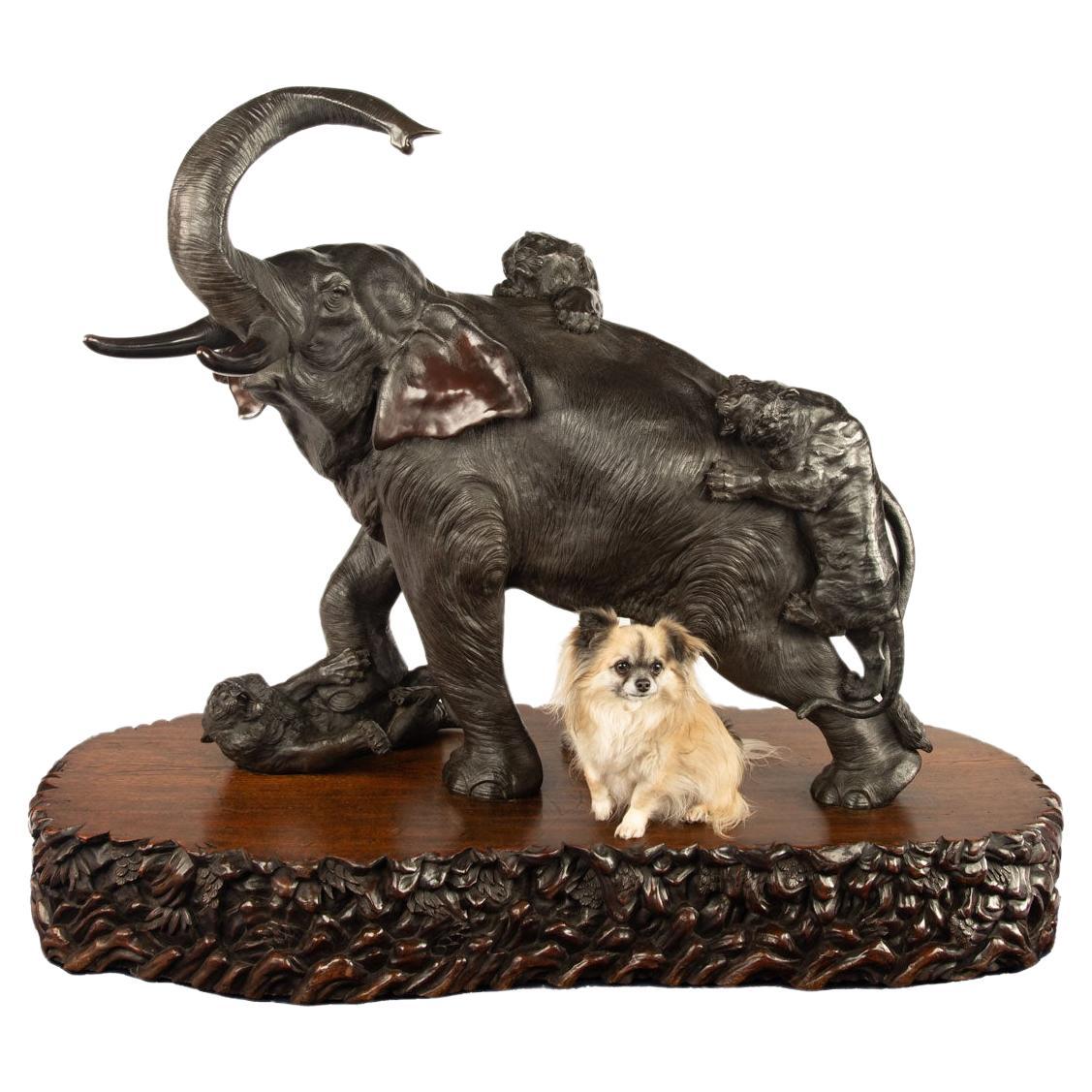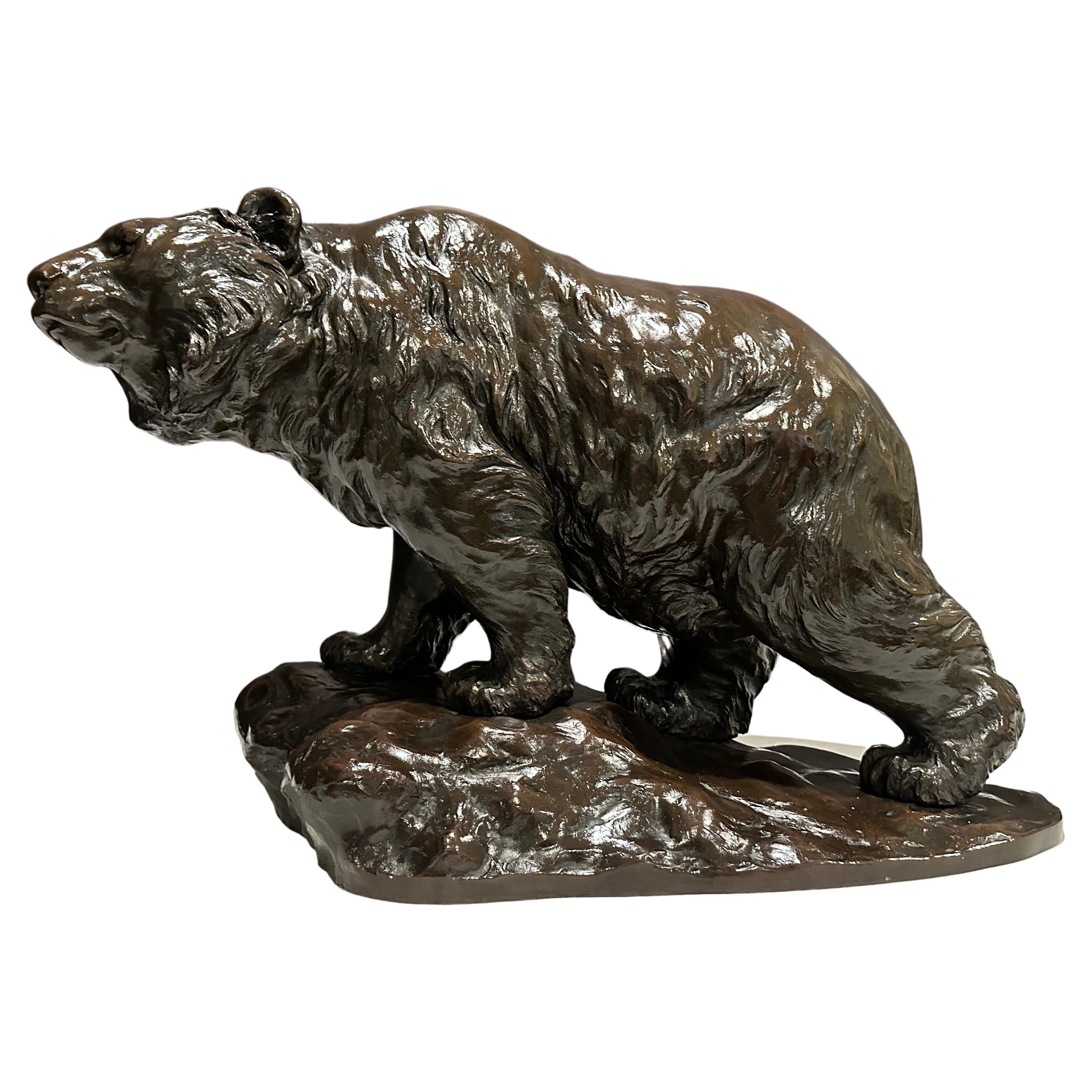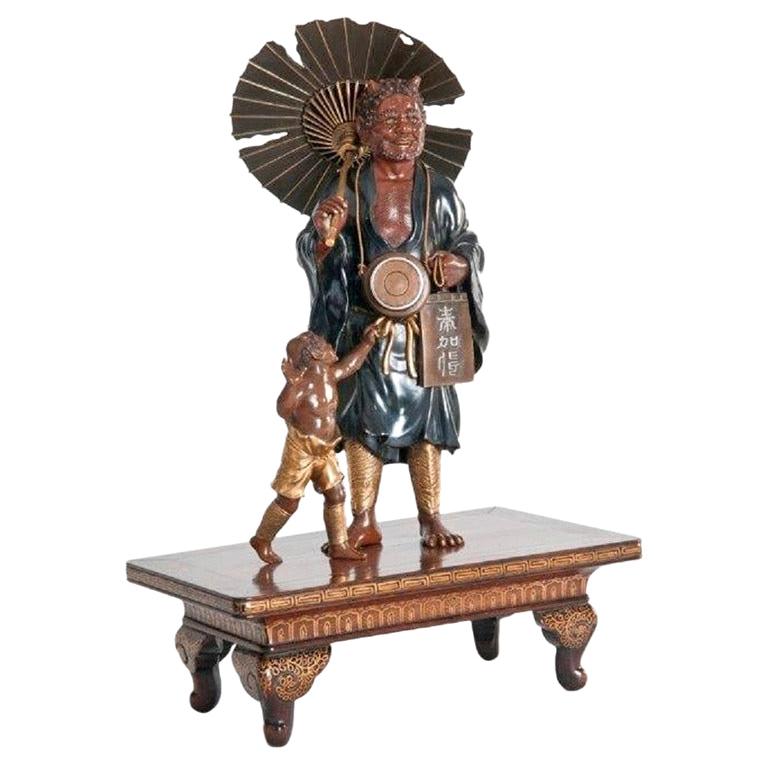Items Similar to Large and Impressive Meiji Period Bronze Bison by Sano Takachika for the Kakuh
Want more images or videos?
Request additional images or videos from the seller
1 of 9
Large and Impressive Meiji Period Bronze Bison by Sano Takachika for the Kakuh
About the Item
A large and impressive Meiji period bronze bison by Sano Takachika for the Kakuha Company, the animal powerfully modelled with his head low and turned slightly to the left and with a naturalistic shaggy pelt, on a shaped rootwood stand, stamped Sano Takachika ???? and Kakuha ??. Japanese, circa 1900.
Sano Takachika probably started out in the metalworking center of Takaoka, home of the Kakuha family. By 1894 he was a member of the Tokyo Chokokai (Tokyo Carvers' Association) and won a Second Class Diploma at the 27th Spring Exhibition of the Nihon Bijutsu Kyokai (Japan Art Association). Noted for his lifelike portrayals of birds and animals there are several works by Takachika in the Khalili Collection. In addition, the Japanese collection formed by the noted English connoisseur, Mr Michael Tomkinson, and published in 1898, included a silver eagle and bronze snake on the trunk of a tree by Takachika.
The Kakuha family had been engaged in metal work and retail pharmacies for many generations in Takaoka (Etchu Province), Toyama Prefecture. They opened a decorative metalwork retail shop in the port town of Yokohama for the export market. The studio often commissioned artists like Sano Takachika.
References:
Oliver Impey and Malcom Fairley, The Nasser D. Khalili Collection of Japanese Art, vol.2, Metalwork Part I, London, The Kibo Foundation, 1995, cat. nos. 120–122.
Michael Tomkinson, A Japanese Collection, London, George Allen, 1898, p.65.
- Dimensions:Height: 12 in (30.48 cm)Width: 27 in (68.58 cm)Depth: 14.5 in (36.83 cm)
- Style:Meiji (Of the Period)
- Materials and Techniques:
- Place of Origin:
- Period:1900-1909
- Date of Manufacture:1900
- Condition:Wear consistent with age and use.
- Seller Location:Lymington, GB
- Reference Number:1stDibs: LU973033010262
About the Seller
5.0
Recognized Seller
These prestigious sellers are industry leaders and represent the highest echelon for item quality and design.
Established in 1982
1stDibs seller since 2013
106 sales on 1stDibs
Typical response time: 4 hours
Associations
LAPADA - The Association of Arts & Antiques Dealers
- ShippingRetrieving quote...Ships From: Lymington, United Kingdom
- Return PolicyA return for this item may be initiated within 14 days of delivery.
More From This SellerView All
- Meiji Period Bronze of an Oni Holding a ParasolLocated in Lymington, HampshireThis figural group shows a mendicant Oni with a tattered umbrella and wearing a voluminous shakudo cloak over gilt tiger mask greaves. A smaller Oni wears s...Category
Antique 1890s Japanese Meiji Figurative Sculptures
MaterialsMetal
- 19th Century Meiji Period Bronze of a Boy Collecting Sweet Chestnuts by SeiyaLocated in Lymington, HampshireA charming Meiji period bronze of a boy collecting sweet chestnuts by Seiya, he carries a basket and is looking down at an insect crawling over his hand, he is also evidently wearing...Category
Antique 1880s Japanese Meiji Figurative Sculptures
MaterialsBronze
- Meiji Period Bronze Sculpture of a LabourerLocated in Lymington, HampshireUnusual Meiji period bronze of a labourer sieving through a woven reed mat with another at his feet and a wooden bucket at his side, signed.Category
Antique 1880s Japanese Sculptures and Carvings
MaterialsBronze
- Large Meiji Period Bronze Tiger by Genryusai SeiyaLocated in Lymington, HampshireLarge Meiji period bronze tiger by Genryusai Seiya, striding forward with teeth bared, the bronze patinated to imitate tiger stripes, with in...Category
Antique 1880s Japanese Animal Sculptures
MaterialsBronze
- Meiji Period Bronze Sculpture of a Mother and Son by AtsuyoshiLocated in Lymington, HampshireA Meiji period bronze sculpture of a mother and son by Atsuyoshi, she is shown seated on a gnarled rootwood base, with her arm round a crying boy standing by her knee and offering her breast, wearing a short robe, trousers and a cloth incised with Mount Fuji around her head, and bare feet. Signed Atsuyoshi saku, Maruki Shachu seisaku (??????????? (??????????). Japanese, circa 1880. Footnote: Atsuyoshi is known for a number of finely modelled bronze studies of both wild and domesticated animals, almost all of them made for the Tokyo based Maruki Company. This is therefore an unusual subject matter for him and Japanese bronzes in general , however Oliver Impey and Joyce Seaman, in ‘Japanese Decorative Arts of the Meiji Period’ (in the Ashmolean Museum Collections), pp. 68-69, include a bronze group of a woman who has just finished breast feeding...Category
Antique 1880s Japanese Meiji Metalwork
MaterialsBronze
- Meiji Period Bronze of a Cricket CatcherLocated in Lymington, HampshireA Meiji period bronze of a cricket catcher, shown holding a whistle to his mouth with his left hand and a long rod in his right hand, wearing traditional clothing with a wide-brimmed...Category
Antique 19th Century Japanese Meiji Figurative Sculptures
MaterialsBronze
You May Also Like
- Important and Monumental Japanese Bronze Okimono – Sano TakachikaLocated in Christchurch, GBAs part of our Japanese works of art collection we are delighted to offer this magnificent huge scale Meiji Period 1868-1912 bronze elephant and tiger group by the leading 19th centu...Category
Antique 19th Century Japanese Meiji Sculptures and Carvings
MaterialsBronze
- Large And Impressive Meiji Period Bronze Bear, SignedLocated in Norwood, NJLarge and impressive patinated bronze sculpture of a bear. As part of our Japanese works of art collection we are delighted to offer this magnificent high quality Meiji period Okimon...Category
Antique Early 1900s Japanese Meiji Sculptures and Carvings
MaterialsBronze
- Japanese Bronze Torii Gate Sculpture Meiji PeriodLocated in Newark, EnglandBeautifully sculpted Japanese Meiji period Torii gate sculpture. The sculpture made from solid bronze with a beautiful patination throughout dating to the Meiji period 1868-1912 circa 1890. The gate of traditional form representing the Matsuo Shrine in Kyoto. The characters read ???? translated directly to Matsuo Shrine. Notes The Torii gate sculpture was crafted after the famous Torii gate which is found in the Arashiyama district in Kyoto. It houses Matsuno’o Taisha (Matsunoo Taisha ????) one of the oldest shinto shrines in Kyoto dating to 701, approximately 100 years before the city of Kyoto. It boarders the mountains and has a distinct main hall dating to 1397 which is also one of the oldest buildings in the city of Tokyo. The shrine’s spring is famous for its restorative properties and sake and miso producer’s patron the shrine with their particular industries relying on the pure water to survive. The distinct giant Torri gate stands at 14 meters tall alluding to its significance in the city. Three beautiful gardens can...Category
Antique Late 19th Century Japanese Meiji Sculptures and Carvings
MaterialsBronze
- Meiji Period Carved Lion and TigerLocated in Pasadena, CAThis is an outstanding pair of Meiji Period carved hardwood figures of a ferocious lion and tiger. The carving is exceptional as is the bone detailing of the mouthes and teeth. The f...Category
Antique Late 19th Century Japanese Meiji Animal Sculptures
MaterialsBone, Hardwood
- Pair of Japanese Gilt Bronze Komainu by Ishikawa Komei, Meiji PeriodLocated in Austin, TXA striking pair of Japanese gilt bronze komainu by the renowned Japanese sculptor, Ishikawa Komei (1852-1913), Meiji period, Japan. The pair well cast, and robustly modeled. They ar...Category
Antique Late 19th Century Japanese Meiji Sculptures and Carvings
MaterialsBronze
- Japanese Tokyo School Bronze Okimono of a Farmer, Meiji PeriodLocated in Austin, TXA very fine and detailed Tokyo School cast bronze okimono (decorative sculpture) of a smiling farmer, Meiji period, late 19th century, Japan. The e...Category
Antique Late 19th Century Japanese Meiji Sculptures and Carvings
MaterialsBronze
Recently Viewed
View AllMore Ways To Browse
Shop For Antique Furniture
Market For Antique Furniture
The Art Metal Company
Retail Shop
Tree Carvings
Bronze Snake
Antique Market London
English Antique Shop
English Antique Shops
Large Bronze Bird
Bronze Port
Antique Shopping London
Antique Shops London
Antique Shop London
English Work Stand
Japanese Silver Sculpture
Animal Carvings
Antique Furniture Market London





